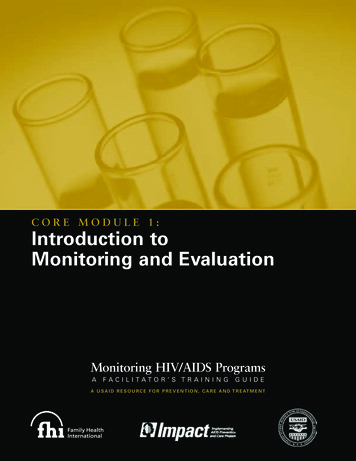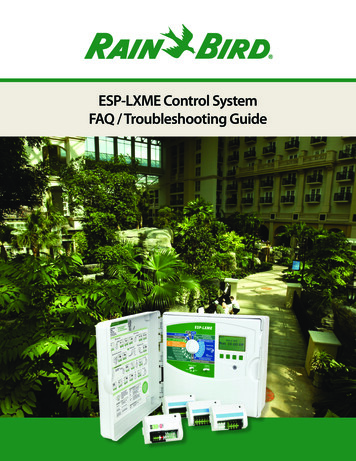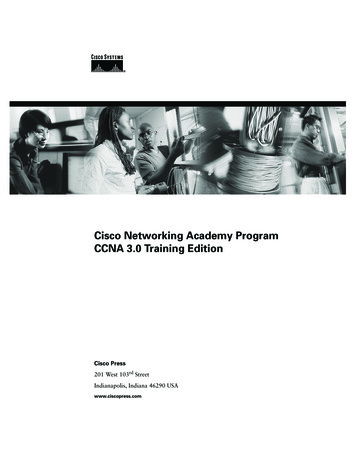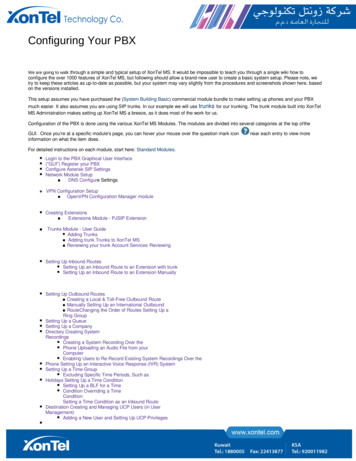
Transcription
CORE MODULE 1:Introduction toMonitoring and EvaluationMonitoring HIV/AIDS ProgramsAFACILITATOR’S TRAININGGUIDEA U S A I D R E S O U R C E F O R P R E V E N T I O N , C A R E A N D T R E AT M E N T
In July 2011, FHI became FHI 360.FHI 360 is a nonprofit human development organization dedicated to improving lives in lasting ways byadvancing integrated, locally driven solutions. Our staff includes experts in health, education, nutrition,environment, economic development, civil society, gender, youth, research and technology – creating aunique mix of capabilities to address today’s interrelated development challenges. FHI 360 serves morethan 60 countries, all 50 U.S. states and all U.S. territories.Visit us at www.fhi360.org.
Monitoring HIV/AIDS Programs: A Facilitator’s TrainingGuideA USAID Resource for Prevention, Care and TreatmentCore Module 1: Introduction to Monitoring and EvaluationSeptember 2004Family Health International
2004 Family Health International (FHI). All rights reserved. This book may be freely reviewed,quoted, reproduced or translated, in full or in part, provided the source is acknowledged. Thispublication was funded by USAID’s Implementing AIDS Prevention and Care (IMPACT) Project, which ismanaged by FHI under Cooperative Agreement HRN-A-00-97-00017-00.
Table of ContentsAcknowledgments . iIntroduction. iiCourse Design .iiiSession Overview and Schedule .1Welcome and Introductions .4Training Norms and Agenda for the Week.5What Is Monitoring and What Is Evaluation? .6Opportunities and Barriers .7Comprehensive Monitoring and Evaluation Framework .8Levels of Monitoring and Evaluation and Responsibilities . 11Goals, Objectives, and M&E Questions . 14Selecting Indicators. 18Monitoring Methods and Tools and Introduction to the Global Spreadsheet. 20Monitoring and Evaluation Work Plan Overview and Introduction. 23Wrap-Up . 25Appendix. 26
AcknowledgmentsThis modular monitoring and evaluation training course is the result of the best thinking and creativityof a large number of individuals throughout Family Health International (FHI), both those in the fieldand those in the Arlington office. While many people provided valuable feedback along the way,several deserve special thanks and acknowledgment for their efforts.First, however, FHI would like to acknowledge the United States Agency for International Development(USAID), which funded the development of this training course through the Implementing AIDSPrevention and Care (IMPACT) Project. FHI would also like to thank its Cambodia, Ethiopia, India, andKenya country offices for donating start-up funds for the initial development of the modules.FHI gratefully acknowledges the work of Beverly Stauffer (consultant) and Julie Victor-Ahuchogu(FHI/Arlington), who helped prepare the initial drafts of each module. FHI also gives special thanks toLisa Heft (consultant), who worked to create the participatory learning exercises and ensure that ourhumanity was not forgotten in the data collection process.In addition, members of the Evaluation, Surveillance and Research Division spent many long hours overthe year working, at times in isolation and at times in groups, to bring the ideas for this training tofruition. We are all very grateful for the hard work of Sonja Schmidt, Susan Pobywajlo, MadalineFeinberg, Laura Porter, and Walter Obiero, all from FHI’s Arlington office.The set of draft modules was pilot-tested in Zambia in July 2003. Before the pilot-testing, a core teamof trainers came together and spent a week revising, upgrading, rewriting, and, ultimately, improvingeach training module to ensure the best training possible. For this hard work, the following individualsdeserve special mention: Sara Hersey, Mike Merrigan, Joseph Kamanga, Bright Drah, Adedoyin Adedayo,Dulce Chahin, Edward Wandia, Seynabou Kasse, Mananza Kone, Addis Tefsfaye, Hilary Bishop Ezeh,Rangsima Airawanwat, Nguyen Thanh Son, Niyongere Audace, Sabina Yasmin, and Donna Sacknoff. FHIwould like to thank those who participated in the FHI global M&E training course (Zambia, July 2003)and the Asia Regional training course (Thailand, October 2003) for providing insightful comments thatwere used in reviewing and finalizing the modules.FHI would like to thank Joshua Volle (Director of the Evaluation, Surveillance and Research Division)and Inoussa Kabore (Associate Director for Monitoring, Evaluation and Research), who, in addition toco-developing the modules, provided the leadership and guidance required to direct the process ofdeveloping, reviewing, and pre-testing the modules.Finally, FHI would like to thank members of the Arlington-based technical and management teams fortheir helpful comments and input during the review and finalization of the modules. Thank you, GloriaSangiwa, Janet Kayita, Judith Harkins, Mukadi Ya Diul, Leine Stuart, Eric van Praag, Gina Dallabetta,Sara Bowsky, Moses Dombo, Kirsten Weeks, David Dobrowolski, Peter Warongo, Jennifer Rubin, CarolLarivee, Paul Nary, Ekong Emah, Tiffany Levefre, and Merywen Wigley.Core Module 1:Introduction to Monitoring and Evaluationi
IntroductionAt the country level, Family Health International’s (FHI) country offices and local staff manage itsHIV/AIDS prevention, mitigation, and care interventions. This modular monitoring and evaluationtraining course is intended for use in training both FHI country program staff and implementing partnerstaff, with the overall goal of building and enhancing the skills required to conduct and carry outquality monitoring and evaluation activities. Ultimately, this will lead to improved programs whosegoals are to prevent the spread of HIV and to provide care and support to those already infected withHIV.The following FHI publications were extremely useful in developing the modules: Evaluating Programs for HIV/AIDS Prevention and Care in Developing Countries: AHandbook for Program Managers and Decision Makers (FHI, 2001) Developing a Comprehensive Monitoring and Evaluation Work Plan for HIV/AIDS and STIPrograms: A Facilitator’s Training Manual (FHI, 2001)It is our hope that by using this modular M&E training package, training participants will be able to: Distinguish between process-, outcome-, and impact-level evaluationsExplain the different monitoring and evaluation conceptual approaches and frameworksIdentify key stakeholders in program monitoring and evaluationIdentify methods for overcoming barriers to effective monitoring and evaluationIdentify appropriate indicators for each technical areaDesign systems to manage and use data and provide feedback to appropriate staffApply general monitoring and evaluation concepts and methods to specific technical areas(e.g., HBC, STI, BCC, VCT, OVC, PMTCT, and clinical care) and to overall program managementDesign country/site-specific monitoring flow process based on organizational structure (e.g.,single country office, field office, or regional office)Design and implement a monitoring and evaluation work plan for a country/site program,taking into consideration donor requirementsCore Module 1:Introduction to Monitoring and Evaluationii
Course DesignThis modular monitoring and evaluation training course is made up of a series of modules that includesthree core modules, which are compulsory and must be taken by all participants, and seven optionaltechnical area modules, which participants will benefit from based on the technical components ofprogram implementation at their specific country/site level.Core Modules Core Module 1: Introduction to Monitoring and Evaluation Core Module 2: Collecting, Analyzing, and Using Monitoring Data Core Module 3: Developing a Monitoring and Evaluation Work PlanWe strongly suggest that Core Modules 1 and 2 precede the other modules because they provide thebackground monitoring and evaluation context on which the technical area modules build. Core Module3 should be taken at or toward the end of the course because it brings together conceptual M&Einformation with the specific technical area information required to develop a monitoring andevaluation work plan.Optional Technical Area ModulesThe technical area modules focus on issues within specific technical areas while applying themonitoring and evaluation concepts that are covered in the core modules. The technical area modulesare: Module 4: Community Home-Based Care ProgramsModule 5: Sexually Transmitted Infection Prevention and Care ProgramsModule 6: Behavior Change Communication ProgramsModule 7: Voluntary Counseling and Testing ServicesModule 8: Orphans and Vulnerable Children ProgramsModule 9: Prevention of Mother-to-Child Transmission ProgramsModule 10: Clinical Care ProgramsTraining MethodologyThe overall training approach used in these modules is based on adult learning theory and is acombination of lectures, discussions, small group work, interactive practical exercises, and role-plays.Core Module 1:Introduction to Monitoring and Evaluationiii
Core Module 1:Introduction to Monitoring and Evaluationiv
CORE MODULE 1:Introduction to Monitoring and EvaluationThis Monitoring and Evaluation series is based on the assumption that Core Module 1 (Introduction toMonitoring and Evaluation) is always the first module, that it is followed directly by Core Module 2(Collecting, Analyzing, and Using Monitoring Data), which is followed by one or more of the optionaltechnical area modules (Modules 4 through 10), and that in all cases the final module is Core Module 3(Developing a Monitoring and Evaluation Plan). The specified sequence is shown below:1. Core Module 1: Introduction to Monitoring and Evaluation2. Core Module 2: Collecting, Analyzing, and Using Monitoring Data3. Optional Technical Area Modules 4 through 104. Core Module 3: Developing a Monitoring and Evaluation PlanLearning ObjectivesThe goal of this workshop is to build the skills of participants in the monitoring of HIV/AIDS preventionand care programs.At the end of this session, participants will be able to: Understand concepts, methods, and tools for intensive and participatory monitoring ofHIV/AIDS prevention and care programs Identify ways to overcome barriers to conducting effective program monitoring Identify key stakeholders in program monitoring and evaluation Select appropriate indicators for measuring program outputs and outcomes Conduct HIV/AIDS program monitoring using appropriate methods and toolsNote: While this training focuses primarily on monitoring, participants will also be introduced tothe concept of evaluation, including when and how to conduct an evaluation, what resources arerequired, and how to use the evaluation results.Session Overview and ScheduleTIME8:30-9:0030 minTOPICA. Welcome and IntroductionsTRAINING METHODFacilitator Presentation9:00-9:2020 minB. Training Norms and Agenda for the WeekFacilitator Presentation9:20-9:4020 minC. What Is Monitoring and What Is Evaluation?Facilitator Presentation,Group Discussions9:40-10:0020 minD. Opportunities and BarriersFacilitator Presentation,Group Discussions10:00-10:1515 minBREAK10:15-11:0550 minE. Comprehensive Monitoring and EvaluationFrameworkCore Module 1:Introduction to Monitoring and EvaluationFacilitator Presentation,Group Work1
Session Overview and ScheduleTIME11:05-12:0055 minTOPICF. Levels of Monitoring and Evaluation andResponsibilities12:00-1:0060 minLUNCH1:00-2:0060 minG. Goals, Objectives, and M&E QuestionsFacilitator Presentation,Group Exercises2:00-2:4545 minH. Selecting IndicatorsFacilitator Presentation,Group Activity2:45-3:0015 minBREAK3:10–4:0060 minI. Monitoring Methods and Tools and Introduction tothe Global Spreadsheet4:00–4:4545 minJ. Monitoring and Evaluation Work Plan Overview andIntroduction4:45–5:0015 minK. Wrap-UpMaterials Flipchart paper and stand Markers Pens or pencils Tape or Blue-Tac Evaluation Form Facilitator Reference: Options for OpeningIntroductions Handout: Example Indicators (slips of paper) Handout: Illustrative Indicators List Handout: Study Designs Overhead: Study Designs (optional) Handout: Comprehensive Monitoring andEvaluation FrameworkTRAINING METHODFacilitator PresentationFacilitator Presentation,Small Group ActivityQ&A Session Signage: Types of Monitoring and Evaluation Handout: Outline of M&E Work Plan Handout/Overhead: Monitoring and EvaluationPipeline Handout: Key Elements of M&E Work Plan Handout: Evaluation Research Questions: Outcome,Impact, Output, Input Handout: Types and Objectives of M&E Handout: Who Should Do What?Handout: Country Monitoring and Evaluation MatrixHandout: Steps in Developing a Monitoring PlanHandout: Project DescriptionsWorksheet: Project Description Handout: Illustration for Input, Output, Outcome,and Impact Workbook for M&E Work Plan Development(distributed separately by facilitator)Core Module 1:Introduction to Monitoring and Evaluation2
Facilitator Note:Set the room up in clusters of 2 to 4 desks with room to walk between them for both the Facilitatorand participants, such as shown below for 20 participants. The Facilitator can walk into the center, andwalk through and around. Participants are asked to take a completely different seat each day so theyhave a new perspective, point of view, and neighbor. This helps people get to know each other.Place a cup/basket with pens, markers, and notepaper in the center of each table cluster. Placenametags, manuals, and handouts on the tables before the participants arrive. Before participantsenter the classroom/training space, hang on the wall a long piece of butcher paper (lengthwise) ormultiple pieces of chart paper right next to each other to form one long chart, and fill in the titles asindicated below. This is the Conocimiento chart.Welcome the participants to the workshop as they come in and invite them to fill out the Conocimientochart (conocimiento [konos ee myen’ toe] is Spanish for knowledge]. Other training team members canthen add their information, after most participants have filled it out. (As the lead facilitator begins,one member of the training team adds up the numbers in each column to get the total years ofteaching, years in HIV work, and age, and provides these to the lead facilitator when asked. Keep thischart up-to-date during the week’s workshop, as you can then refer to it to show examples of conceptssuch as mean, quantifiable, and so on, as you touch on these terms in the data module during thistraining. You can also review them before the M&E Work Plan module to determine what groups tobreak participants into for developing their work plans and make the seating arrangement at the tableclusters for that day.)Conocimiento ChartNameAge Gender CountryType ofHow long I worked My favorite aspect ofwhere I program or in HIV prevention monitoring/evaluationwork interventionand careMy greatest challengeregardingmonitoring/evaluationSource: Each One Reach One, curriculum developed for inmate peer educator training for prisons and jails in the United States.Facilitator Note: Some participants may not feel comfortable filling out some or all of the chart forvarious reasons, such as literacy/writing skills and/or privacy. Encourage them to participate asmuch as they feel they can and allow them to not complete any area that is not comfortable tothem.Core Module 1:Introduction to Monitoring and Evaluation3
A.Welcome and Introductions8:30-9:008:30-8:4530 minA. Welcome and IntroductionsFacilitator Presentation(15 min)Facilitator Note: The main point of this activity is to identify and highlight the strengths andexperiences that the participants bring to the training. Therefore, it is not only the facilitators whoare bringing important information to the training, but also the participants, who have valuableexperience and skills to share. It is important to facilitate this activity early in the training to set atone that is based on universal learning by the entire group and not didactic “expert” teaching bythe facilitators.1. IntroductionWelcome participants and introduce yourself and other members of the team.The goal of the training is to build your skills for project and program monitoring and evaluation forHIV/AIDS care and prevention programs.The objectives of this week’s training workshop is to give you the information and tools you need to: Better understand issues, conceptual approach, and framework for monitoring and evaluatingHIV/AIDS/STI prevention and mitigation programs and care and treatment programs Identify ways to overcome barriers to conducting effective program monitoring and evaluation Identify key stakeholders in program monitoring and evaluation Select appropriate monitoring methods and develop/and or adapt required monitoring tools forgeneral and specific programs and technical areas Select appropriate indicators for measuring program outputs and outcomes Identify major steps involved in planning for data collection, processing, and reporting forprogram monitoring and evaluation Map data flow and identify who is responsible for monitoring the quality of data Understand how to analyze, present, and interpret data Understand how data can be used for advocacy and decision-making Develop and/or review and implement a monitoring and evaluation work plan for your countryor site program, taking into consideration your donor, country, site, and governmentrequirements.Indicate the Conocimiento Chart and acknowledge that there is great wisdom among the gatheredgroup—from “school” knowledge to life experience—and that we will all be learning much from oneanother in this training. Explain that this chart represents the total knowledge the group brings to thistraining. Briefly review/highlight some of the comments written by different members of the group insome of the categories. Make sure to identify the “totals,” such as the total number of years working inthe area of HIV/AIDS. This allows you to recognize the experience within the group. For example youmay say “that there are 252 years of life experience within this group. Therefore the group holds agreat deal of wisdom and knowledge that they may be able to use and share with others on top of theinformation and skills that we (the facilitators) bring to the training.”Core Module 1:Introduction to Monitoring and Evaluation4
8:45-9:00(15 min)Facilitator Note: Select one of the options described in Facilitator Reference: Options for OpeningIntroductions in the appendix for opening the week, to create an opportunity for participants to get toknow one another and gain a sense of who they are working with. You may select either option orcreate your own. Option 1: Do you use first names in these workshops across all cultures? You cancertainly address each other as “Mr. ” and “Ms. ” if you think you and your participants aremore comfortable with a more formal tone. Following is a refreshing icebreaker, and people sing inmany cultures—this can weave cultures and voices together. Option 2: This is not only a goodicebreaker to get people moving, but also shows people how much they have in common.Example: “The Wind Blows” Similarities and Differences Exercise If the size and shape of the room allows, ask participants to create a circle of their chairs.Remove your own chair so that you are standing to introduce this activity. “This is an activitycalled ‘The Wind Blows,’ and it is similar to a child’s game that in some countries is calledMusical Chairs. I will say something that is true for me, and if it is also true for you, you mustget up and find a new seat.” Note that if anyone has mobility issues they should feel free to stay in their place in the circleand not move around, but rather imagine when they would move if they share things incommon. Begin with an easy one: “The Wind Blows for someone who did not eat breakfast thismorning.” Assist everyone to get up and find a new seat (including you). Whoever is leftstanding leads the next round. Encourage participants to say something that is true for them (let them know that it does nothave to be serious, but that it can be any light and easy thing) and help them start theirsentence by saying “The Wind Blows for someone who ” and everyone then changes seats. Continue this for another few rounds and then during the chaos of everyone finding their seats“find” yourself standing as the one without a seat. This brings you back into the center, whereyou can now go deeper into content that is connected to this workshop series. Say, “Now I am going to say a truth regarding what I find challenging about evaluation ” andlet them continue it for a few rounds with their own shared challenges. Then find yourself inthe middle again to say “Now I am going to say what I enjoy about evaluation” and so on.Source: S. Joshua Volle, PhD, Family Health InternationalB.Training Norms and Agenda for the Week9:00-9:2020 minB. Training Norms and Agenda for the WeekFacilitator PresentationCreate Training NormsCover the agenda for the week, as appropriate:Day 1:Core Module 1: Introduction to Monitoring and EvaluationDay 2:Core Module 2: Collecting, Analyzing, and Using Monitoring DataDay 3:Option 1: Orphans and Other Vulnerable Children ProgramsOption 2: Sexually Transmitted Infection (STI) Prevention and Care ProgramsDay 4:Option 1: Voluntary Counseling and Testing ServicesOption 2: Behavior Change Communication ProgramsCore Module 1:Introduction to Monitoring and Evaluation5
Day 5:Option 1: Community Home-Based Care ProgramsOption 2: Prevention of Mother-to-Child Transmission ProgramsCore Module 3: Developing a Monitoring and Evaluation Work PlanOption 1: Clinical Care ProgramsDay 6:Talk about and review this day’s agenda with participants.C.What Is Monitoring and What Is Evaluation?9:20-9:4020 minC. What Is Monitoring and What Is Evaluation?Facilitator Presentation,Group DiscussionsMaterials Handout : Evaluation Research Questions: Outcome, Impact, Output, Input Handout: Illustration for Input, Output, Outcome, and Impact Signage: Types of Monitoring and Evaluation Overhead: Study Designs Handout: Study DesignsFacilitator Note: Watch your pace—keep it lively, energetic, and moving forward because it isprimarily the dynamic of them listening to you for 1 hour, and you have a lot to cover. The idea isto discuss the basic concept and terminologies of M&E and harmonize comprehension of languageand concept, so that the participants and facilitators “speak the same language.” Many people viewM&E with preconceived ideas, which can prevent them from carrying out the necessary activities.This section is designed to allow participants to clarify their concepts about monitoring (primarily)and about evaluation (secondarily), to share their feelings about M&E, and to discuss the value ofM&E and the particular opportunities and barriers they will confront when conducting M&Eactivities.Brainstorming Session: What Is “Monitoring?” and What Is “Evaluation?”Ask each table group to come up with a list of what Monitoring and Evaluation (M&E) is and what it isnot. Give them 5 minutes to discuss. Lead the group in a full discussion on M&E. Do this by quicklygoing from group to group and asking them to shout out one thing at a time while you write it down onthe flip chart. Organize the ideas into two columns: “What M&E is” and “What M&E is not.” Then askeach table to come up with a definition for “monitoring” and a definition for “evaluation.” What is Monitoring? What is Evaluation?Facilitator Note: Signage (signage begins on page 25 of appendix) should be prepared beforeparticipants arrive and be ready for placement. The signs should be placed evenly around the wallsof the room in clockwise order. They should be laid out in this way to focus on the concepts ofFormative Assessment, Process, Impact/Output, etc., as well as on what stage of the process youare in and what you are doing with these different approaches. Walk over and refer to theInput/Output and then the Outcome/Impact signs to indicate and dramatically emphasize these asyou mention them throughout the day. It is useful to keep these signs posted during the nextmodule (Core Module 2: Collecting, Analyzing, and Using Monitoring Data) as well.Core Module 1:Introduction to Monitoring and Evaluation6
Next facilitate a discussion about how the two are different: How are they different? How do they fit together?Fill in the discussion with the following points:Definition:Monitoring is the routine process of data collection and measurement of progress towardprogram objectives. Monitoring involves counting what we are doing. Monitoring involves routinely looking at the quality of our services.Definition:Evaluation is the use of social research methods to systematically investigate a program’seffectiveness. Evaluation requires study design. Evaluation sometimes requires a control or comparison group. Evaluation involves measurements over time. Evaluation involves special studies.Facilitator Note: Focus the participants on WHY it is important to conduct Monitoring and Evaluation(e.g., as a management tool to improve the design and implementation of programs, fund raising,to fulfill reporting requirements).At the end of the discussion, introduce the idea that most implementing partners and agencies are notexpected to carry out rigorous evaluation, but that we rely on them for routine monitoring and datacollection. In addition, country offices have the added responsibility of not only monitoring theirprograms and sub-agreements, but also of thinking about what needs to be evaluated and when itneeds to be evaluated.D.Opportunities and Barriers9:40-10:0020 minD. Opportunities and BarriersFacilitator Presentation,Group DiscussionsIntroduce this segment by saying: “All settings present particular opportunities and barriers toconducting monitoring and evaluation work. It is important to know what these are up front so that weare able to use our strengths and overcome the barriers.”Ask the participants to state opportunities they see to carrying out M&E, and then ask them to statebarriers to conducting M&E. Facilitators should write the participants’ responses on the flipchart in twocolumns: “Opportunities” and “Barriers.”Now ask for 8 volunteers: 4 to be barriers and 4 to be M&E specialists who will try to convince eachbarrier, one at a time, through discussion and explanation, that the barrier can be dropped. If andwhen the person playing the barrier feels they are convinced, they will cross the room and join theother group.Core Module 1:Introduction to Monitoring and Evaluation7
Ask all the participants to keep these opportunities and barriers in mind for ways to build on theiropportunities and for ways to overcome their barriers as they go through the week.10:00-10:15E.15 minBREAKComprehensive Monitoring and Evaluation Framework10:15-11:0550 minE. Comprehensive Monitoring and EvaluationFrameworkFacilitator Presentation,Group WorkMaterials Handout: Comprehensive Monitoring and Evaluation Framework Handout/Overhead: Monitoring and Evaluation PipelineReview the following: Formative Assessments, Monitoring (inputs, process, outputs, and measuringquality), and Evaluation (assessment of outcome and impact). Refer to the definitions and key conceptsdiscussed previously during the training.Overview of Monitoring and Evaluation Framework Monitoring and evaluation takes place at multiple stages of a program. At each stage we gatherdifferent information that comes together to demonstrate how the project has been conductedand what has occurred as a result. It is important to identify at the outset how we will gatherthe information for each level of evaluation. It is also important to keep in mind that some of these stages overlap and can, in differentsituations, represent different levels. For example, outcome-level data on risk behaviors oftarget groups can be used to evaluate the effectiveness of a program or set of programswithout associating the changes with any single program. Remind participants that the framework presented below is a general framework for discussionpurposes and that it has fluid boundaries. Use the Handout: Comprehensive Monitoring and Evaluation Framework. Walk around the roomplacing the signs for each type of M&E on the wall and next to each sign quickly explain thefour main types of evaluations.Comprehensive Monitoring and Evaluation FrameworkTypes of Monitoring and Evaluation:FormativeAssessments andResearch(concept and design)Monitoring(monitoring inputs,processes, and outputs;assessing servicequality)Evaluation(assessing outcome andImpact)Cost-EffectivenessAnalysi
A FACILITATOR'S TRAINING GUIDE A USAID RESOURCE FOR PREVENTION, CARE AND TREATMENT. In July 2011, FHI became FHI 360. FHI 360 is a nonprofit human development organization dedicated to improving lives in lasting ways by advancing integrated, locally driven solutions. Our staff includes experts in health, education, nutrition,











